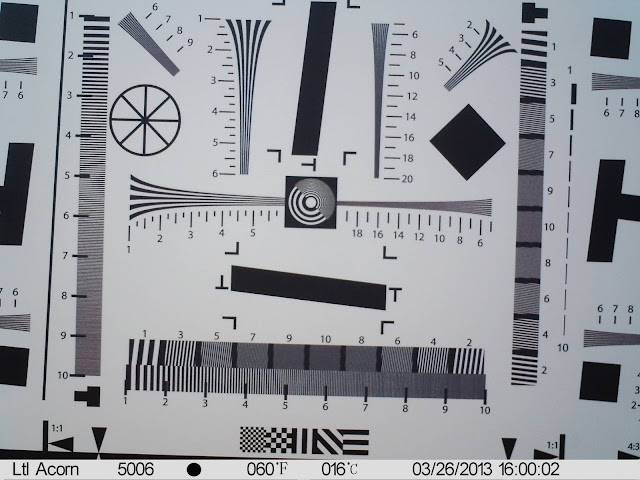 |
| Fig 1: Great Tit and Blue Tit trying out the feeder I'm using for the close focus tests with the Acorn 5210A Click image to view full size |
Adrian Jevons using an Acorn 6210 http://ourwildlifegarden.weebly.com/
Kate MacRae using Bushnells http://wildlifekate.wordpress.com/category/close-up-kit/
Both have achieved good results applying external close up lenses of various diopters.
Kate has produced her own piece of
commercial kit as an add on to the Bushnell cameras.
While effective this method does however involve hanging bits and pieces on the outside of the camera and to my mind this is impractical in many field environments.
 |
| Fig 2: Bench test at 10cm |
I particularly want to use the Acorn cameras for small mammals and in such applications the camera can often be in a vulnerable situation close to the ground where animals such as badgers and pine marten will almost always show too close an interest.
 |
| Fig 3: Bench test at 20cm |
Another issue with using an externally mounted lense is fogging and rain falling on the lens.
 |
| Fig 4: Bench test at 30cm |
Upon investigation I found that the lens is a single element in a plastic mounting which is located directly over the image sensor. It has a screw thread which can be adjusted to change the position of the element relative to the sensor.
During manufacture the lens is adjusted and the threads are locked into position using something similar to plumbers tape. With gentle persuasion this will unlock to allow repositioning of the lens element but with enough friction remaining between the threads to prevent the lens self adjusting during use.
 |
| Fig 5: Bench test at 40cm |
Bench test results using a 5210A are shown left in figures 2 (10cm) to 8 (70cm) and proved a perfectly acceptable result through 20 to 60 cm.
My assistants for the first field trial were small birds and a badger. The distance from the camera lens to the wire mesh on the feeder is 45cm.
 |
| Fig 6: Bench test at 50cm |
 |
| Fig 7: Bench test at 60cm |
The perfect solution for reducing the level of IR lighting at distances of around a metre or less is a single thickness of PVC adhesive backed camo tape which produces the result shown in figure 10.
 |
| Fig 8: Bench test at 70cm |
 |
| Fig 9: Normal IR at 45cm |
In the next day or two I will try and post results using a 6210MC and I will also illustrate how to carry out the modification.
Click on any image to view a slideshow.
 |
| Fig 10: Reduced IR at 45cm |


